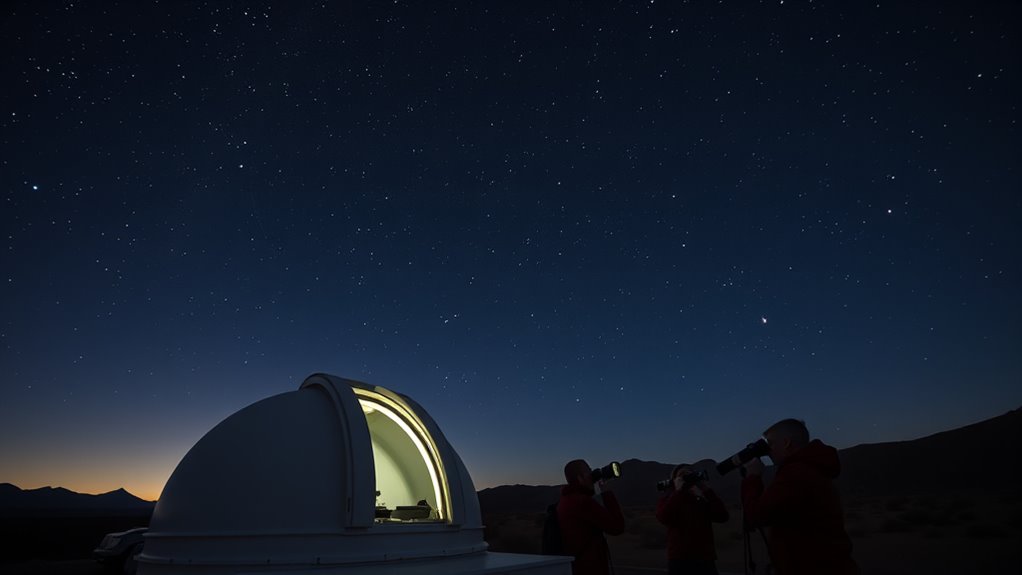Scientists keep hunting for Planet X because tiny gravitational effects on distant objects suggest a hidden ninth planet might be out there at the solar system’s edge. Despite advances in telescopes and infrared surveys, this distant world remains faint and elusive, making detection incredibly challenging. The clues from orbit anomalies inspire ongoing searches, using new techniques and technologies. If you keep exploring, you’ll discover how astronomers piece together these celestial mysteries and push closer to finding this mysterious planet.
Key Takeaways
- Anomalies in TNO orbits suggest gravitational influences from an unseen ninth planet.
- Historical evidence and gravitational calculations motivate ongoing searches for Planet X.
- Modern techniques like infrared surveys and precise astrometry aim to detect faint, distant objects.
- Discovering Planet X would expand understanding of the solar system’s formation and dynamics.
- Despite challenges, continuous technological advancements keep the search for the hidden planet active.

Have astronomers found evidence of a mysterious ninth planet lurking at the edge of our solar system? The idea has intrigued scientists and skywatchers for decades. While we haven’t yet confirmed its existence, the search continues because of intriguing clues and advanced detection techniques. Historically, searches for unseen planets have gone through various phases. Early astronomers relied on visual observations and calculations based on gravitational effects, but today, we use sophisticated detection techniques to hunt for Planet X.
In the past, astronomers looked for anomalies in the orbits of known planets or moons. These historical searches helped shape our understanding of where a hidden planet might be hiding. Modern detection techniques now include precise measurements of the positions and motions of distant objects, especially trans-Neptunian objects (TNOs). When the orbits of these icy bodies seem to be influenced by an unseen mass, scientists suspect a larger planet could be nearby. By analyzing the gravitational influences on these objects, astronomers narrow down the potential location of Planet X.
Another key detection technique involves looking for direct images of the planet itself. This requires powerful telescopes equipped with sensitive cameras and advanced image processing. Because Planet X, if it exists, would be far away and faint, astronomers need to distinguish its light from background stars and galaxies. They often use infrared observations, since a cold, distant planet would emit faint heat signals detectable in infrared wavelengths. Space-based observatories like the Wide-field Infrared Survey Explorer (WISE) have been instrumental in this aspect, scanning the sky for objects that don’t match known celestial bodies.
Despite these technological advancements, the hunt remains challenging. The vastness of space, combined with the faintness of a potential planet, makes detection difficult. Still, scientists remain optimistic because the clues from orbital anomalies, combined with improved detection techniques, keep the search alive. They continuously refine their methods, analyze new data, and plan targeted surveys in promising regions of the sky.
Recent developments in cybersecurity vulnerabilities related to astronomical data systems have underscored the importance of protecting observational data from potential interference, which could hinder the search for Planet X. Ultimately, the search for Planet X is driven by curiosity and the desire to understand our solar system better. Each new observation and technique brings us closer to answering whether a hidden ninth planet exists. The combination of historical searches’ lessons and cutting-edge detection techniques keeps the pursuit active. Until we find definitive evidence, the possibility remains tantalizing, inspiring ongoing exploration and discovery at the edge of our cosmic neighborhood.
Frequently Asked Questions
What Would Be the Exact Size of Planet X?
You’re probably wondering about Planet X’s size, which is estimated to be about 2 to 4 times Earth’s mass, roughly 4,000 to 8,000 kilometers in diameter. Its orbital dimensions suggest it orbits far beyond Neptune, with a highly elongated orbit taking hundreds of years. While exact measurements are uncertain, astronomers believe its planet size is large enough to influence other celestial bodies’ orbits, making it a compelling target for ongoing searches.
How Long Would It Take to Find Planet X?
A watched pot never boils, and finding Planet X can take years due to detection challenges. The search duration depends on the planet’s size, distance, and how effectively telescopes and data analysis work together. Typically, it could take several years or even decades, as astronomers carefully scan the sky and analyze data. Patience is key, because discovering Planet X is a complex process that demands persistence and advanced technology.
Could Planet X Affect Earth’s Orbit Significantly?
Planet X could potentially influence Earth’s orbit through its planetary influence, but it’s unlikely to cause significant orbital disruption. If the planet is far enough away, its gravitational pull won’t drastically alter Earth’s path. However, a more massive or closer Planet X could have noticeable effects. You should keep an eye on astronomers’ research, as understanding its position and mass helps determine how much it might impact Earth’s orbit over time.
Has Any Direct Evidence of Planet X Been Found?
No, you haven’t found direct evidence of Planet X yet. It’s like chasing a shadow in the fog—planet X theories spark excitement, but observational challenges make proof elusive. Astronomers sift through data, hoping to catch a glimpse, yet the planet remains hidden, hiding behind cosmic curtains. Despite advances, the search continues, driven by the hope that someday, this elusive world will step into the light and reveal itself.
What Technology Is Used in the Search for Planet X?
You rely on advanced telescopes with improved sensitivity and resolution to scan the outer solar system. These telescopes leverage recent advancements in technology, allowing you to detect faint objects. You also use sophisticated data analysis techniques to sift through vast amounts of data, identifying potential Planet X candidates. Together, telescope advancements and data analysis help you increase your chances of discovering this elusive ninth planet.
Conclusion
As you continue to explore the mysteries of our solar system, remember that astronomers have tracked over 20 trans-Neptunian objects, hinting at Planet X’s possible existence. Despite decades of searches, the quest persists because this hidden ninth planet could be 10 times more massive than Earth. Your curiosity fuels ongoing discoveries, reminding us that the universe still holds many secrets waiting to be uncovered. The search for Planet X remains one of astronomy’s most exciting adventures.








